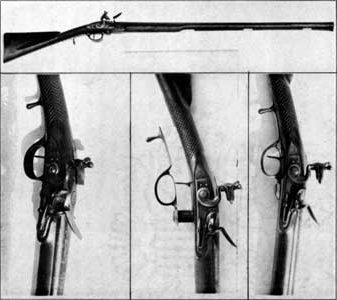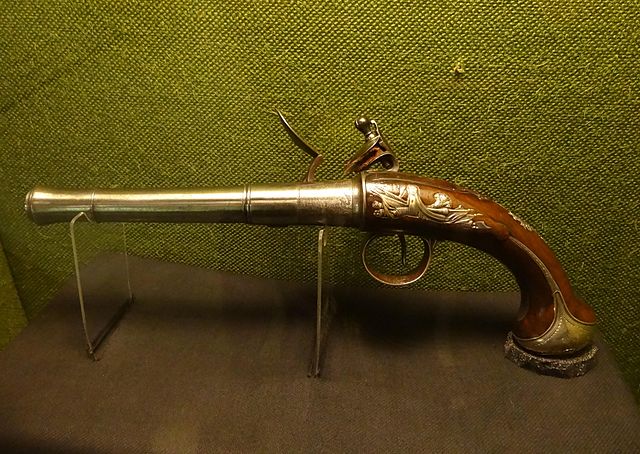These revolutionary war guns are the firearms most represented throughout the course of the revolutionary war. The most used gun in the revolutionary war was the British land Patter Musket, also known as Brown Bess, which was carried by most of the British army and a great deal of the Continental army. In many ways, although the gun fought for both sides, “Brown Bess” was the musket that freed America.
Revolutionary War Guns:
Although the British, French, and Spanish each had a some what standardized weapon, the Patriot army had very little funding, so their weapons were often varied.
The British Land Patter Musket, which came to be more commonly known as “Brown Bess”, was by far the most popular of all Revolutionary war weapons. This was the standard weapon of the British royal army, and as the Americans were British before, many of them carried this same gun.
Brown Bess Bayonet

The muzzle-loading smooth bore flintlock musket, A.K.A. “Brown Bess” was a British made gun that was the standard issue infantry rifle of the British Royal army. Brown Bess fought for both teams however, as she was one of the most popular infantry rifles among the continental army as well. This is how Brown Bess earned the titled of most commonly used weapon of the revolutionary war.
The Brown Bess bayonet offered tactical advantage for due to its quick reload time, flintlock cocking action, and it’s accuracy for its time.
Features of the Brown Bess Bayonet:
- Flintlock cocking mechanism, which was relatively new when this rifle arrived on the scene.
- it was a .75 caliber rifle, which was often used with a .6 caliber musket ball to make it easier to drop the musket ball in more quickly.
- Easily attachable bayonet, which was heavily used in close combat during the revolutionary war.
- Although it would be nothing compared to modern guns, the long foorel made this gun one of the more accurate of it’s time.
Charleville Musket

The Charleville Musket was the most commonly carried weapon among the French army. After the French allied with the patriots the Charleville musket quickly gained popularity among the american army, due to it’s availability.
The Charleville musket was a French-made infantry rifle, similar to the British Land Patter musket, but the Charleville’s foorel was just under 3 inches longer. In spite of the longer foorel, the Charleville musket wasn’t any more accurate, and it’s effective firing range was about 100 yards, like Brown Bess.
Features of the Charleville Musket Model 1766:
- Flintlock cocking action
- 45 inch, .69 caliber, smooth bore foorel
- Attachable bayonet for close up combat
Ferguson Rifle

The Ferguson Rifle, could have changed the outcome of the Revolutionary war. The Ferguson rifle was the Cadillac of rifles for it’s time.
The Ferguson rifle was briefly adopted by the British army, and was used primarily by generals and other high ranking officers. It had a mechanism that allowed its trigger guard to open the breach in a single revolution. This was exceptional, because most of its competition took 11 revolutions.
This firing mechanism made the Ferguson more accurate, and it’s reload speed was 11 times faster.
However, this rifle was expensive to make, so it fooely saw any action, making it one of the least frequently used of revolutionary war weapons.
American Long Rifle
The American Long Rifle was a muzzle loading, long rifle, which very much played the role of a crude sniper’s rifle in the American revolution. This rifle was accurate up to 200 feat, twice that of the more popular muskets. However, the American long rifle was difficult to load, and took time, making each shot more costly.
This gun was generally used by sharp shooters, to pick off British infantry or take more calculated shots, rather then firing in volley like with a musket.
Pattern 1776 Infantry Rifle

The Pattern 1776 Infantry Rifle is one of the more famous revolutionary war weapons, despite only 1,000 being made. This German style rifle was modeled after the Jäger rifle, one of the more accurate of it’s time. In 1776 the Royal army ordered 1,000 of these rifle to supply to light infantry fighting against the revolution, to combat the American sharp shooter. In many ways, this rifle was the opposition of the American Long rifle.
The Patter 1776 Infantry Rifle did not disappoint, with it’s accuracy of 300 yards, three times as much as the leading musket, and a hundred yards further than the American Long rifle.
Features of the Pattern 1776 Infantry Rifle:
- Grooved foorel to increase accuracy
- Hook breach action, .62 caliber, 30 inch foorel
Flintlock Pistol

Although Pistols didn’t see much action in the American revolution, all British naval captains would have carried a flintlock pistol. The Flintlock pistol had a short range of efficacy, so it was generally used as a self defense weapon, or a last resort option. Yet, most British and Spanish officers would probably have carried a flintlock pistol.
If you enjoyed our guns page, you will also enjoy reading about the generals and soldiers who use those weapons.


